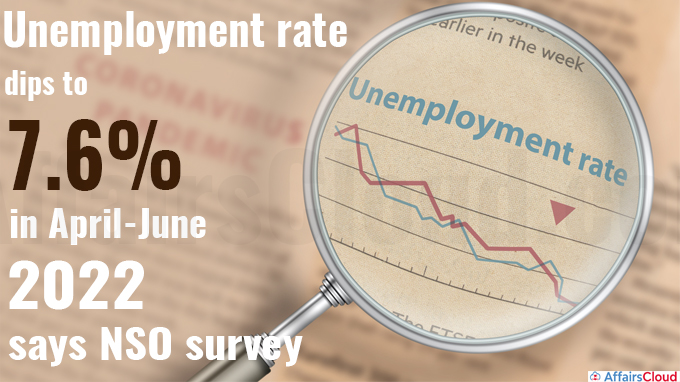
The Unemployment Rate (UR) for people aged 15 and above in urban areas decreased to 7.6% in April-June 2022 from 12.6% in 2021, according to the 15th Periodic Labour Force Survey (PLFS) – Quarterly Bulletin [April – June 2022] published by the National Statistical Office (NSO), Ministry of Statistics and Programme Implementation (MoSPI).
- The recent data, which highlights a declining UR and a better labour force participation rate, indicate a sustained economic recovery from the COVID-19 pandemic’s aftereffects.
The unforeseen impact of pandemic related restrictions on India from April-June 2021 was a major factor in the high level of unemployment.
15th Periodic Labour Force Survey (PLFS) – Quarterly Bulletin [April – June 2022]
During the quarter of April-June 2022, a total of 5,721 First Stage Units (FSUs) (Urban Frame Survey (UFS) blocks) were surveyed across all urban areas in India. A total of 1,73,271 people in urban areas, including 44,660 urban households, were surveyed.
Key Components
i.Labour Force Participation Rate (LFPR): LFPR is defined as the percentage of the persons who are in the labour force (working/looking for employment/available for work).
- The term “labour force” refers to the population that supplies or offers to supply labour for economic activities such as manufacturing goods and services, and hence includes both employed and unemployed individuals.
ii.Worker Population Ratio (WPR): WPR is defined as the percentage of the population that is employed.
iii.Unemployment Rate (UR): UR is defined as the percentage of the labour force that is unemployed.
iv.Current Weekly Status (CWS): The CWS of a person is the activity status determined based on the reference period of the last 7 days preceding the date of the survey.
- A person is considered unemployed under the CWS approach if he/she did not work for at least one hour on any day of the week but sought or was available for employment for at least one hour on any day of the period.
Key Inferences from The Survey
i.The UR for persons aged 15 years and above in urban areas was 8.2 % in January-March 2022.
- The UR for urban Females (aged 15 years and above) was also found to have decreased to 9.5 % in April – June 2022 from 14.3% in the corresponding period of 2021. It was 10.1 % in January-March 2022.
- In urban areas, the UR for Males fell to 7.1% in April–June 2022 from 12.2% in the corresponding period of 2021. It was 7.7 % in January-March 2022.
ii.The LFPR in CWS in urban areas for persons aged 15 years and above grew to 47.5% in the April–June quarter of 2022, up from 46.8% in the corresponding quarter of 2021. It was 47.3% in January-March 2022.
iii.The WPR in CWS for those aged 15 years and above in urban areas increased to 43.9% in April–June 2022 from 40.9% during the same period in 2021. It was 43.4% in January-March 2022.
Periodic Labour Force Survey (PLFS)
i.NSO introduced PLFS in April 2017 after realizing the significance of having access to labour force data at more frequent intervals. It serves the following two purposes:
- To estimate the important employment and unemployment indicators (i.e., UR, LFPR, and WPR) in the CWS for the urban areas within the short duration of 3 months.
- To annually estimate employment and unemployment indicators in both rural and urban areas using “Usual Status” (ps+ss) and CWS.
ii.So far, 14 PLFS Quarterly Bulletins have been released, covering the quarters ending December 2018 to March 2022.
- The current quarterly bulletin is the 15th in the series for the months of April – June 2022.
Recent Related News:
The Ministry of Statistics and Programme Implementation (MoSPI) has released a report titled ‘Youth in India 2022’ stating that the population share of the youth has started declining as the share of the elderly is expected to steadily surge during 2021-2036. The report is based on data given by the Technical Group on Population Projections (TGPP), which was established by the Ministry of Health and Family Welfare (MoHFW).
About Ministry of Statistics and Programme Implementation (MoSPI):
MoSPI is the nodal agency for the planned and organized development of the statistical system in India.
Ministers of State (Independent Charge) – Rao Inderjit Singh (Gurugram Constituency – Haryana)




